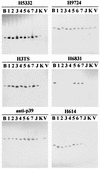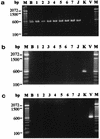Genospecies identification and characterization of Lyme disease spirochetes of genospecies Borrelia burgdorferi sensu lato isolated from rodents in Taiwan
- PMID: 9774551
- PMCID: PMC105287
- DOI: 10.1128/JCM.36.11.3127-3132.1998
Genospecies identification and characterization of Lyme disease spirochetes of genospecies Borrelia burgdorferi sensu lato isolated from rodents in Taiwan
Abstract
Lyme disease spirochetes of the genospecies Borrelia burgdorferi sensu lato were identified and characterized for the first time in Taiwan. Seven isolates, designated TWKM1 to TWKM7, were purified from the ear tissues of three species of rodents captured from seven localities of Taiwan. The immunological characteristics of these Taiwan isolates were compared with those of other genospecies of Lyme disease spirochetes by analyzing the protein profiles and reactivities with B. burgdorferi-specific monoclonal antibodies (MAbs). The genospecies of these Taiwan isolates were also identified by the similarities in their plasmid profiles and differential reactivities with genospecies-specific PCR primers. Although two distinct protein profiles were observed among the seven Taiwan isolates, the MAb reactivities against the outer surface proteins of B. burgdorferi of all of these isolates were consistent with those of B. burgdorferi sensu lato. The similarities of the plasmid profiles also confirmed the identities of these Taiwan isolates. PCR analysis indicated that all of these Taiwan isolates were genetically related to the genospecies B. burgdorferi sensu stricto. These results demonstrate the first identification of Lyme disease spirochetes in Taiwan and also highlight the increasing demand for defining the reservoirs and vector ticks of B. burgdorferi. A serosurvey for Lyme disease infection in the human population of Taiwan may also be required.
Figures





Similar articles
-
Genetic analysis of the outer surface protein C gene of Lyme disease spirochaetes (Borrelia burgdorferi sensu lato) isolated from rodents in Taiwan.J Med Microbiol. 2002 Apr;51(4):318-325. doi: 10.1099/0022-1317-51-4-318. J Med Microbiol. 2002. PMID: 11926737
-
An OspA-based genospecies identification of Lyme disease spirochetes (Borrelia burgdorferi) isolated in Taiwan.Am J Trop Med Hyg. 2002 May;66(5):611-5. doi: 10.4269/ajtmh.2002.66.611. Am J Trop Med Hyg. 2002. PMID: 12201600
-
Lyme disease in Taiwan: primary isolation of Borrelia burgdorferi-like spirochetes from rodents in the Taiwan area.Am J Trop Med Hyg. 1998 Nov;59(5):687-92. doi: 10.4269/ajtmh.1998.59.687. Am J Trop Med Hyg. 1998. PMID: 9840582
-
The need to unravel the twisted nature of the Borrelia burgdorferi sensu lato complex across Europe.Microbiology (Reading). 2020 May;166(5):428-435. doi: 10.1099/mic.0.000899. Microbiology (Reading). 2020. PMID: 32125267 Review.
-
Population genetics, taxonomy, phylogeny and evolution of Borrelia burgdorferi sensu lato.Infect Genet Evol. 2011 Oct;11(7):1545-63. doi: 10.1016/j.meegid.2011.07.022. Epub 2011 Aug 5. Infect Genet Evol. 2011. PMID: 21843658 Free PMC article. Review.
Cited by
-
Distribution of Borrelia burgdorferi sensu lato in China.J Clin Microbiol. 2011 Feb;49(2):647-50. doi: 10.1128/JCM.00725-10. Epub 2010 Nov 24. J Clin Microbiol. 2011. PMID: 21106783 Free PMC article.
-
First detection and molecular identification of Borrelia garinii spirochete from Ixodes ovatus tick ectoparasitized on stray cat in Taiwan.PLoS One. 2014 Oct 24;9(10):e110599. doi: 10.1371/journal.pone.0110599. eCollection 2014. PLoS One. 2014. PMID: 25343260 Free PMC article.
-
Molecular typing of Borrelia burgdorferi sensu lato: taxonomic, epidemiological, and clinical implications.Clin Microbiol Rev. 1999 Oct;12(4):633-53. doi: 10.1128/CMR.12.4.633. Clin Microbiol Rev. 1999. PMID: 10515907 Free PMC article. Review.
-
Molecular detection of Borrelia valaisiana-related spirochetes from Ixodes granulatus ticks in Taiwan.Exp Appl Acarol. 2010 Dec;52(4):393-407. doi: 10.1007/s10493-010-9372-x. Epub 2010 Jun 29. Exp Appl Acarol. 2010. PMID: 20585840
-
Prevalence and molecular identification of Borrelia spirochetes in Ixodes granulatus ticks collected from Rattus losea on Kinmen Island of Taiwan.Parasit Vectors. 2012 Aug 10;5:167. doi: 10.1186/1756-3305-5-167. Parasit Vectors. 2012. PMID: 22882955 Free PMC article.
References
-
- Ai C X, Wen Y X, Zhang Y G, Wang S S, Qui S S, Shi Z X, Li D Y, Chen D Q, Liu X D, Zhao J H. Clinical manifestations and epidemiological characteristics of Lyme disease in Hailin county, Heilongjiang Province, China. Ann N Y Acad Sci. 1988;539:302–313. - PubMed
-
- Baranton G, Postic D, Saint Girons I, Boerlin P, Piffaretti J C, Assous M, Grimont P A D. Delineation of Borrelia burgdorferi sensu stricto, Borrelia garinii sp. nov., and group VS461 associated with Lyme borreliosis. Int J Syst Bacteriol. 1992;42:378–383. - PubMed
Publication types
MeSH terms
Substances
Grants and funding
LinkOut - more resources
Full Text Sources
Medical

